John Williams and Sons, Grocers
Davenport Station home | Index to History pages
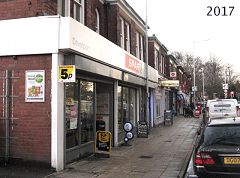
In addition to the many 'corner' shops which served local customers, the early twentieth century saw the development of chains of grocery shops, often developed by tea merchants. Some of them became national, and others which had confined themselves to smaller areas, were swallowed up by larger groups later in the century and are largely forgotten today.
One of these was John Williams and Sons Ltd, of special interest to us because not only did they have a branch in Davenport, the founding family also lived here.
This feature has not been the easiest to compile, and we would welcome any further information, including photographic records of their stores.
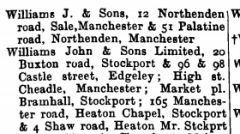
From a 1906 directory
John Williams & Sons, 1966/67
Compiled from Telephone Directories, so not guaranteed 100% accurate or complete. Corrections welcome.
[M]=later branded Maypole
[L]=later branded Lipton's, c. 1972
Head office, Stanley Road Cheadle Hulme (later, as Liptons, by 1972, at Cheadle Hulme Precinct)
Bramhall 9-11 Bramhall Lane South, [L]
Bramhall Fir Road, [M]
Brooklands 179 Washway Road,
Buxton 73 Spring Gardens,
Cheadle 186 Wilmslow Road.
Cheadle 138 Turves Road [L]
Cheadle Hulme 4 Shopping Precinct, [M-L]
Cheadle Hulme Cheadle Road,
Cheadle Hulme 20 Church Road, [M-L]
Davenport 209-211 Bramhall lane, [L]
Didsbury 447 Wilmslow Road,[M]
Didsbury 703 Wilmslow Road, (45-49 re-numbered) [M-L]
Didsbury 254 Fog Lane, [L]
Didsbury (West) 97 Lapwing Lane, [M-L]
Disley 22 Market Street, [M-L]
Edgeley 96-98 Castle Street, [M]
Firswood 211 Upper Chorlton Road, Manchester 16 [L]
Gatley 3 Church Road, [L]
Great Moor 295 Buxton Road, [M]
Hale 30 Park Road,
Handforth 118 Wilmslow Road, [M-L]
Heald Green 250 Finney Lane, [L]
Heaviley 135 Buxton Road [M]
Heaton Chapel 165 Manchester Road, [M]
Heaton Chapel 341 Wellington Road North, [M]
Heaton Chapel 76 Heaton Moor Road [L]
Heaton Moor 125 Heaton Moor Road,
Ladybarn 100 Mauldeth Road Manchester 14 [M]
Levenshulme West Point, Manchester 19
Longsight 574 Stockport Road, Manchester 13 [L]
Manchester 62 Oldham Street
Northwich 15 Witton Street,
Marple 27 Stockport Road, [M-L]
Marple 14 Market Street,
Middleton 229 Wood Street,
Poynton Fountain Place [M-L]
Radcliffe Unit 1, Blackburn Road, [L]
Romiley 43 Compstall Road, [L]
Sale 10 Brooklands Road, [M-L]
Sale 12 Northenden road, [M]
Stockport 35 St Petersgate,
Stretford 38 King Street,
Timperley 110 Park Road, [M]
Timperley 228 Stockport Road
Timperley (West) 336 Manchester Road [M]
Wilmslow Grove Street
Withington 74 Mauldeth Road West Manchester 20 [M]
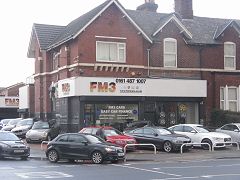
135 Buxton Road, 2017
Other known sites
Recorded in earlier directories but not listed in 1967, presumably closed by then:Head Office, 400 Dickenson Road, Longsight
Didsbury (West) 50-52 Burton Road,
Stockport 16-20 Buxton Road,
Stockport 1 St. Petersgate (Later 1-3)
Levenshulme 686 Stockport Road,
Fallowfield. 269 Wilmslow Road.
Cheadle 53 High street,
Cheadle 67 High Street,
Levenshulme 72 Stockport road,
Rusholme 261 Wilmslow Road,
Heaton Moor 4 Shaw road,
Cheadle Hulme 37 Station road,
Northenden 51 Palatine road,
Hale 176 Ashley road,
Stockport 35 St Petersgate,
Chorlton-cum-Hardy 32 Beech Road,
Chorlton-cum-Hardy 93 Manchester Road,
Wilbraham Road, Manchester 21
Withington 71 Wilmslow Road
Hazel Grove 162 London Road,
Heaviley 20 Buxton Road,
Heaton Chapel 341 Wellington Road North
Heaton Mersey 446 Didsbury Road,
Heaton Norris 149 Wellington Road North,
Levenshulme 892 Stockport Road
Stretford 860 Chester Road,
Stretford 15 Edge Lane,
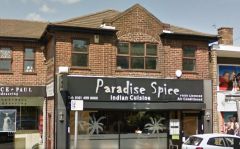
250 Finney Lane, 2016: Indian Cuisine
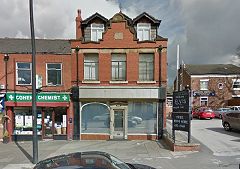
446 Didsbury Road, Heaton Mersey, 2016
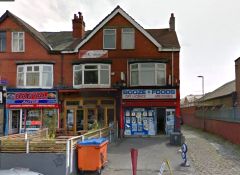
211 Upper Chorlton Road, 2016: 'Booze and Foods'
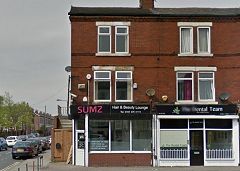
860 Chester Road Stretford, 2016: Hair and Beauty Lounge
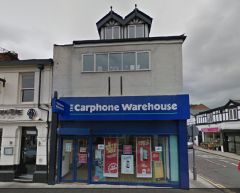
67 High Street Cheadle, 2016: Mobile phones (Same building as 1 Massie St.)
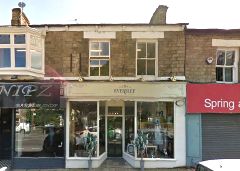
22 Market Street Disley 1016: Home decor
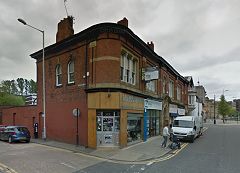
35 St Petersgate, Stockport 2016: Climbing and Ski-ing equipment
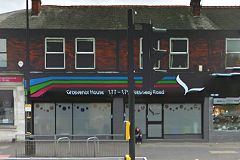
179 Washway Road, Brooklands 2016: Offices
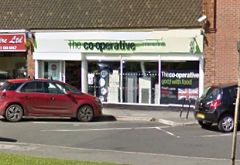
138 Turves Road, Cheadle: Co-Op
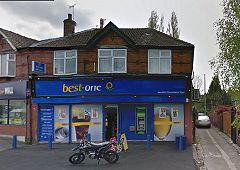
100 Mauldeth Road: Convenience store
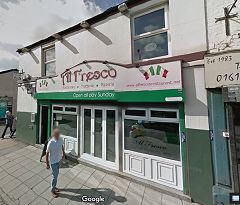
162 London Road, Hazel Grove: Trattoria
The Williams homes in Davenport
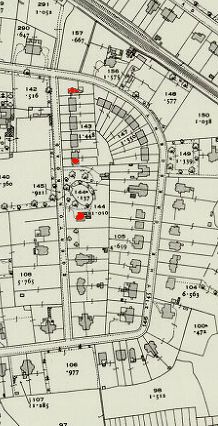
This map from the 1920s shows in red the homes of the Williams family in the Egerton Road area. At the top is John Williams' house at 6 The Crescent, then just north of the pond Walter's house 'Garfield' No.15 Egerton Road, and to the south 'Broadfield' with its grounds including the pond.
The map shows that northern and southern parts of the road developed in different ways by the purchases of plots of land from the estate of the Davenports of Bramall Hall in the 1870s and 1880s.
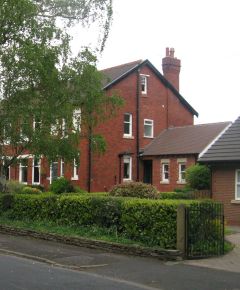
'Garfield' in 2015. In recent times a bungalow has been built between Nos 15 and 21.
Development of housing, in what was intended as a private estate, was slow, despite the proximity of Davenport Railway station; the segment-shaped area at the north end was used by a nurseryman until purchased by Jessie Lumb in 1902, as related in our Jessie Lumb and the Crescent feature. The land opposite was part of the grounds of large houses on Bramhall Lane until many years later.
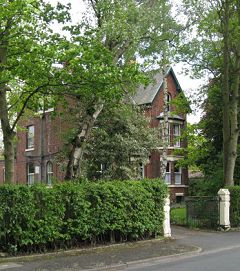
Broadfield, 2015
The plot of land at the south end of Egerton Road, including the site of 'Broadfield', was bought from the Davenport estate in 1881 by Robert Stockdale. Born in in Bolton, he had come to Stockport in the 1840s; the 1851 census lists him as Grocer and Tea Dealer in Churchgate,
By the 1870s, Robert Stockdale was living at No.2, The Grove, Shaw Heath and running a grocery shop nearby at 110 Shaw Heath. By 1881, the family had relocated to 108 Shaw Heath, next door to the shop. 108 and 110 survive in 2020 as part of the premised of Harry Bates, supplier of bathroom furniture, established in 1966.
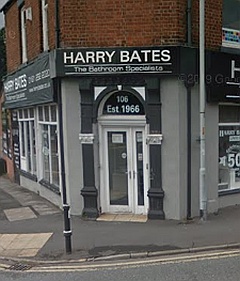
The original ornate surround to the corner door of 110 (renamed 106) can still be seen in 2020.
It appears that Robert commissioned the large new house, and named it 'Broadfield' - perhaps for the village north of Manchester between Bury and Rochdale with may have had special meaning to the couple. Their son Robert Airton Stockdale gained a University degree and set up a small 'high school' in a building on Heath Road, Cale Green.
After Robert (senior)'s death in 1893 'Broadfield' was sold in 1896 to Ebenezer John Williams by Stockdale's widow Mary Elizabeth and son John Joseph. Mary Elizabeth Stockdale lived with her son Thomas and his family at 13 Dale Street until her death in 1902. The Shaw Heath shop passed, by 1902, to Sharples & Co., 'grocers & agents for Gilbey's wine merchants'.
The Williams family moved to Davenport from Didsbury, and 'Broadfield' remained the Williams family home until 1922, when following the death of John (senior) and his wife it was put on the market.
The asking price was £2000, including 4000 square yards of land. By 1924 the householder was Arthur Lofthouse, a wholesale jeweller, with his wife Laura. One of a family of jewellers, he had business premises in Manchester.
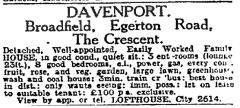
Advert, 1934
In 1934 it was for sale on a lease basis (£100 per year), described as an 'easily-worked family house' with three entertaining rooms, eight good bedrooms, all conveniences, large garden, immediate possession. 'Only wants seeing.'
The 1937 Electoral Register lists Phyllis Doreen Mitchell (born 1900) as resident at No.21. She is listed in the 1939 register as a 'Matron'. Also there was a Nora Donnarumma, possibly a housekeeper, or student?
Arthur Lofthouse died in September 1946 in Southport; the house had been sold earlier that year by his widow Laura to Ronald Lester Jones and Joan Margaret Jones. Sadly, Ronald died just a year after they moved in.
By the 1960s The house had gained a new role as 'Broadfield House', a 'Working Girls' Hostel accommodating 10 girls aged 15 to 18. (Press advert, 1965).
Since 1978 the house has been the property of Stockport Borough Council, and is used as a children's home, augmented by an additional building in the grounds. A curious feature is the pond in the grounds, a survivor of many which once found all over the area.
Contributions and comments are very welcome at at info@davenportstation.org.uk
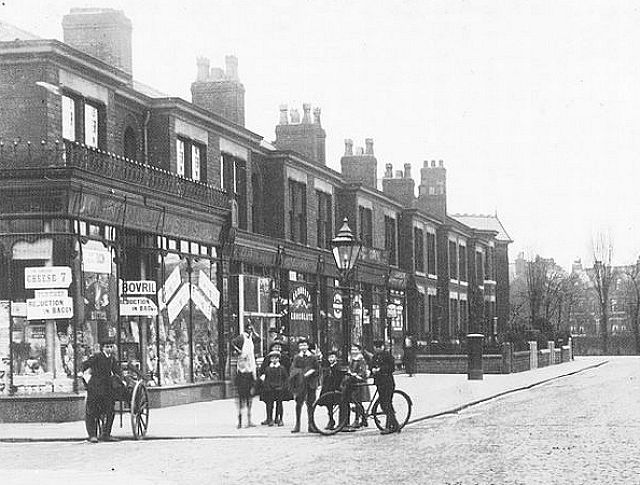
This picture, which also appears in our Davenport Post Office feature, shows (on the left) the John Williams and Sons grocery premises, opened in converted houses at 209-211 Bramhall Lane, Davenport sometime around 1914. The small shops alongside, also converted from houses, were (we believe) also owned by John Williams and rented to small shopkeepers, including the Post Office at 219 which in 2017 still flourishes.
The Williams family story
Ebenezer John Williams was born in 1843 in Bengeworth, a village across the River Avon from the market town of Evesham, Worcestershire. His father, also John Williams, also a native Bengeworth, was, like others in the village, a 'Nailer' and the family home was in Nailers' Row. Nail-making in small workshops was a common common in the 'black country' and Worcestershire area, but by the 1840s there was competition from machine-made nails, as described in an article on the Sedgley Manor website:
Machinery for nail-making was being developed, first the cast nail in 1780, and in 1811 cut nails began to be manufactured in Birmingham. By 1830 they were being produced in large numbers, Hand-made nails were also being imported in increasing amounts from Belgium adding to the distress of the nailers. During the 'Hungry Forties the people in the nail trade suffered terribly and by 1842 many of them were dying of starvation.A Williams family, headed by John Williams and his wife Mary Ann, can be found on the 1851 and 1861 Census for Bengeworth, but although it appears these surely are his parents, young Ebenezer John, who would have been aged eight in 1851, does not appear. Could it be that he was sent to 'Industrial School' where the children of poor parents would learn a trade? It would be interesting to know how more about his 'journey' from poverty in a nail-making village in Worcestershire to a grocery business in industrial Lancashire.
The earliest document we can find on-line for Ebenezer John Williams relates his marriage on 16 September 1865, at which time he was working as a grocer at 43 Bury Street in the Lancashire industrial city of Salford, adjacent to Manchester. His bride, Hannah Sherrington, was the daughter of a tailor, George Sherrington, of 50 Bury Street. Bury Street in 2017 runs between some industrial buildings and new blocks of flats, but in 1865 it was lined with small houses and shops.
Young Mr Williams must have had considerable business acumen, as by 1871, aged 27, he was running a grocery shop in up-market Wilmslow Road, Didsbury, Manchester, living there with his wife Hannah, and sons Arthur (aged 3) and George (1). In 1881 the family was still at the Didsbury shop 'employing 1 man and 1 boy' now with two more sons Walter (b. 1874) and John (b.1876) , daughter Mary, and also living with them a niece, Maud Fletcher. By 1891 all the family except Maud was still living 'above the shop' - and all four sons are listed as 'Grocer's assistant.' There was also a boarder, Hannah's sister Rachael Sherrington, described as a milliner. By this time, he had largely dropped his first name 'Ebenezer', naming his business 'John Williams and Sons.'
For the first time in 1891 the census-taker gives us the actual address of the shop, an impressive brick building at 45-47 Wilmslow Road, Didsbury. The family was still intact and living at the shop, with Rachel Sherrington. The 1890s must have been a time of great change, as establishment of a network of branches began and the boys grew up and joined the firm: in 1896 the family re-located to Davenport, including Rachel Sherrington, now described as their cook. Their new home was 'Broadfield', 21 Egerton Road, a large detached house with six bedrooms and three 'entertaining rooms.' Rachel Sherrington acted as their housekeeper, later assisted by a housemaid (Amy Pearce in 1911).
John Williams (senior) died in December 1921 aged 78. the year after the death of his wife Hannah: his obituary in the Manchester Guardian tells us:
He started in business at Didsbury in 1865; today the firm has 26 branches. He took the initiative in the promotion of technical education in the grocery trade and was one of the founders of most of the existing trade societies such as the Federation of Grocers, The Institute of Certificated Grocers, the Northern Council of Grocers' Associations, and the Manchester and District Grocers' Association. His were among the first shops in the Manchester district to adopt early closing.He left an estate worth £30,000 to be administered by his four sons. It's clear that he was devoted to his trade and its promotion as a profession. There is no evidence of any ambitions to local politics, or other civic duties.
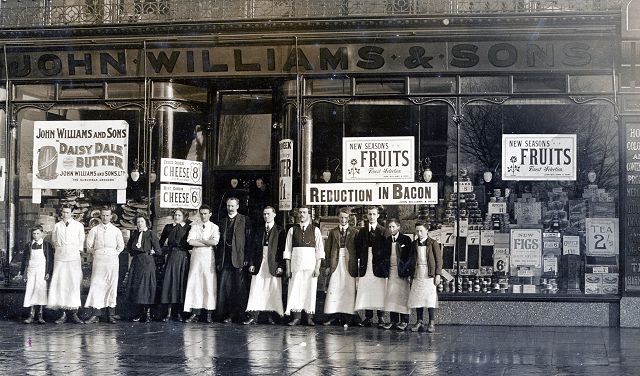
50-52 Burton Road, West Didsbury, with manager and staff.
The four brothers
All four sons, Arthur, George, Walter and John joined the family firm, all describing themselves as Directors in 1911.Arthur Williams apparently stayed at Broadfield until his father died; later he lived at 'Whingarth', 44 Frewland Avenue, Davenport.
George Williams is recorded in the 1901 census records (aged 31) living at 57 Albert Road, Levenshulme with his Scottish-born wife Janet, baby daughter Ethel and a servant, Lizzie Pinder. Perhaps he was managing the Levenshulme branch of the grocery. However, by 1911 they had returned to Davenport, at 'Ardlui', 18 Clifton Road, on the Davenport Park estate a few minutes' walk from Egerton Road. Ardlui is a settlement near Loch Lomond in Scotland, and Janet Williams was born in Dunoon, Scotland; an example of the common practice at that time of the name being chosen by the lady of the house. Ethel remained their only child. They were still at 'Ardlui' in 1929, but after retirement moved to a house in Torkington Road, Hazel Grove.
Walter Williams left 'Broadfield' but did not travel very far. By 1911 he was the occupier of 'Garfield', No.15 Egerton Road, at that time the next house along from 'Broadfield' to the other side of the pond which can still be seen on Egerton Road. His wife, Ida Garfield Williams (née Tomkins), brought an exotic touch to the family; she was born in Brooklyn, New York, U.S.A. As was the tradition, she clearly chose the name of the house. They had two daughters born in Davenport: Jessie Sherrington Williams (born c. 1906) and Greta Mary Garfield Williams (born 1911). A third daughter, Beryl Robertson Williams, was born in 1913. In 1911 they had two live-in servants, Mary Annie Sarah Potts (24, cook) and Elizabeth A. Hacking (34, nurse). By 1928 they were at 'Ash Green', Ladythorn Crescent, Bramhall, a very exclusive address. Walter died in 1953; Ida lived until 1970.
John Williams (junior) purchased a house at No. 6 The Crescent, 'Ingleside', again very close to 'Broadfield.' He distinguished himself in 1915 by driving an ambulance, donated by the company, to the battlefields of France to rescue wounded soldiers from the battle lines, under the auspices of the Red Cross. For his efforts he was awarded the Croix de Guerre. By 1928 he was at 34 Egerton Road, and was still there in 1946. John G. Williams, at 50 Egerton Road in 1946, may have been his son.
The Suburban Grocer
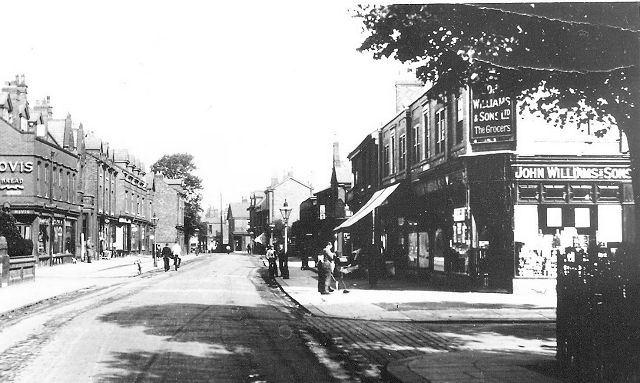
Beech Road, Chorlton-cum-Hardy, 1932. This branch was later transformed into the 'Mayfair Laundrette' and in 2017 is the 'Laundrette' bar and restaurant.
The company John Williams & Sons Ltd, self-titled 'The Suburban Grocer', flourished in the early decades of the twentieth century; eventually there was hardly a settlement in the southern suburbs of Manchester, and commuter towns as far as Buxton and Northwich, without one or more of their stores, as well as Stockport and Manchester town centres and a few to the North of Manchester. They applied their own distinctive branding to their shops, featuring the company name above the window in capitals on a red background behind glass, and - where possible - decorative ironwork above the fascia, as seen in our heading picture. Company headquarters for many years was at 400 Dickenson Road, Longsight, south Manchester, adjacent to the A6 Main Road.
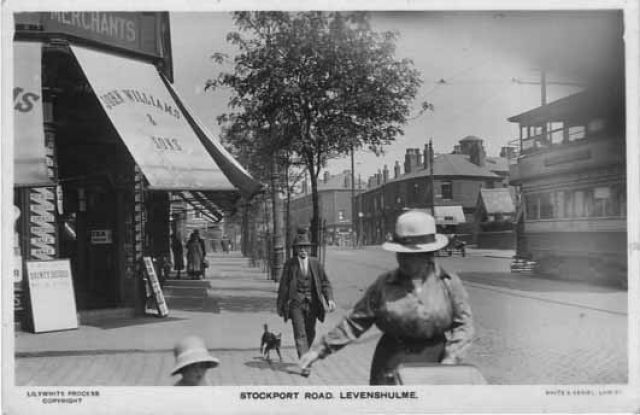
892 Stockport Road, Levenshulme (A Subway fast-food shop in 2017)
Not all the buildings appear to have been custom-built as shops, some being converted from existing houses or commercial premises in strategic locations; a newspaper item from 1955 mentions 'nearly 70' branches.
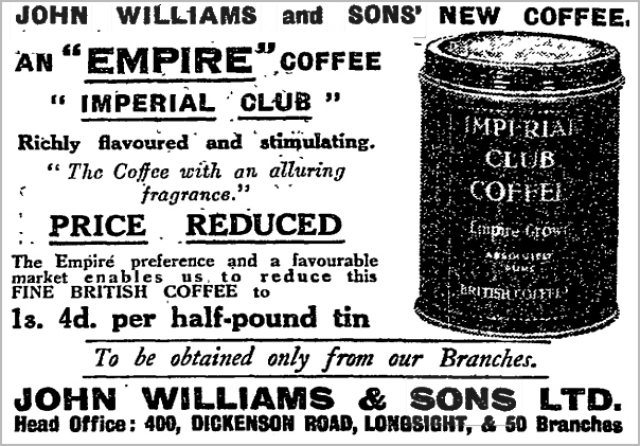
Newspaper advertisement, 1932
Later days
The Williams Brothers eventually sold the company (we have not yet established exactly when) to Allied Suppliers, a national group which had been formed in 1929, initially under the name of one its components, Home and Colonial Stores.
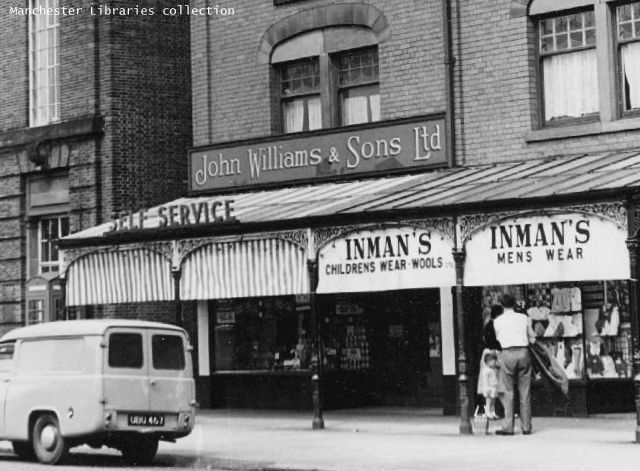
97 Lapwing Lane as self-service store, 1960. In 2016, it was a wine shop.
The John Williams name was retained, as a name for the company's North West Region, until the 1960s, by which time some effort was being made to adopt self-service and other modern retail practices. Supermarkets were opened in new shopping precincts at Cheadle Hulme, Stalybridge, and even Kirby new town in Merseyside, but closures were inevitable, especially where more that one of the company's various brands were trading in close proximity.
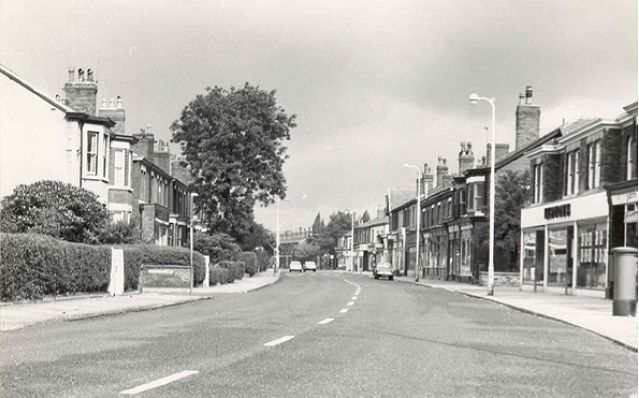
Bramhall Lane, Davenport, 1972
By 1968 the Allied group had closed and sold around 1600 of its 3000-or-so shops, including the former Burgon's store on the corner of Kennerley Road at 235 Bramhall Lane. The business at 209-211 Bramhall Lane survived, and was expanded by purchasing the shop at No. 213 and incorporating it into the store, as the 1972 picture above shows.
For a short period around this time, it operated under another brand; the photograph above, dated 1972, lacks the resolution to decipher the name on the fascia, but it is probably MAYPOLE. Does anyone recall this? The name of another subsidiary, Maypole Dairies, was applied to many John Williams stores by 1971.
Not long afterwards, however, there was a change of policy and another long-standing brand name 'Lipton's' was adopted and the former John Williams branches, including 209-213 Bramhall Lane, came under the Lipton's (North West) umbrella.
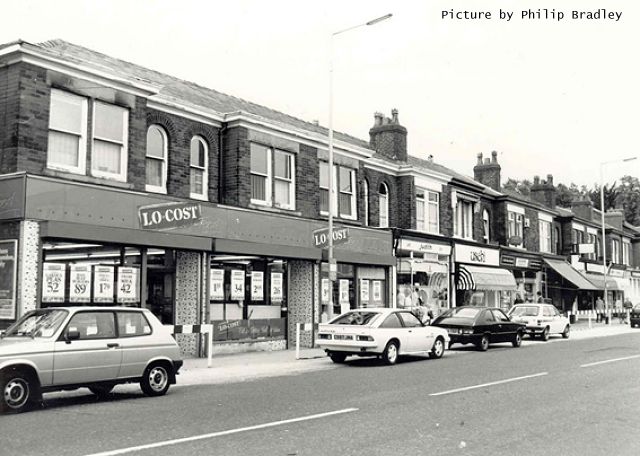
Lo-Cost, Davenport, 209-213 Bramhall Lane, 1989
A complex web of mergers and sales in subsequent years led to the Davenport store, some others in the area, being sold to the Argyll Group, who in 1987 bought the UK Safeway Supermarket chain from its American parent, and re-branded as 'Lo-Cost', which lasted until 1995 when the store was sold to Lancashire-based James Hall and Company, the North West distributors of goods to the international 'Spar' brand.
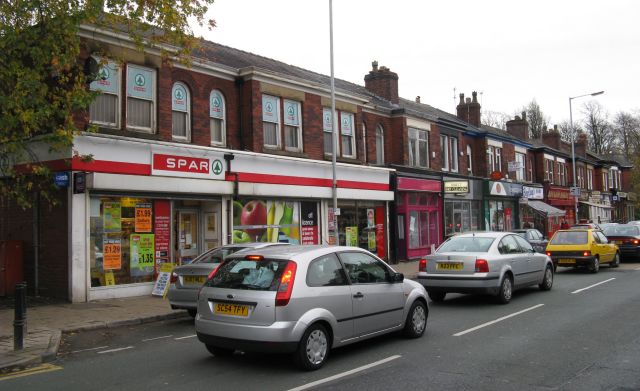
The original 'Spar' photographed in 2009, already a historic view
It was operated as a Spar on a franchise basis by a local businessman until one evening in February 2014 when a van arrived and took away all the stock from the store, which failed to open for business the next day, leading to wild speculation by local residents. We made contact with James Hall & Co. who assured us that they were trying to find a new operator but there were complications. Eventually they decided to operate the shop directly, and a totally refurbished store re-opened in November 2014, to everyone's relief, and still serves the community in 2017 as this is written.
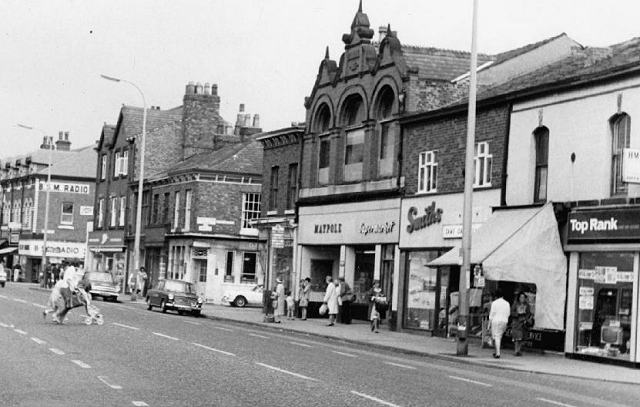
703 Wilmslow Road, Didsbury, c.1970
Davenport has been lucky: of the other John Williams stores, further cutbacks by owning groups over the years mean that just a handful of former Williams sites still operate in the grocery (or convenience store) business, although in many cases the buildings can still be found, as seen from our illustrations. The original Didsbury store, 45-49 Wilmslow Road, operated as 'Maypole Supermarket' - another Allied subsidiary - for a while around 1970 (above), but like many others has since been given over to other sorts of traders, some of which John Williams senior could never have imagined.
The Edgeley store
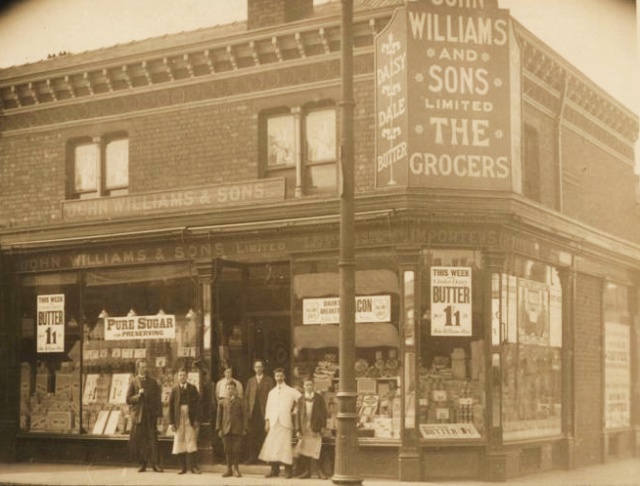
Not far from Davenport is 96-98 Castle Street, Edgeley, seen above on this postcard, along with its staff. The date is unknown; later than 1902 as the postcard has a 'divided back' and the pole for tram wires was erected in 1904.
These buildings were constructed circa 1889 by Joseph Davenport Kain, Master Builder and Local Councillor. In the 1891 census No.96 was a Pork Butcher's and 98 a Greengrocer. (The angled corner of No.96 was probably the original doorway. ) A 990-year lease for No.98 was signed in October 1894 by Ebenezer John Williams, and it became his first branch in Stockport. No doubt he was able to add no.96 later as opportunity arose.
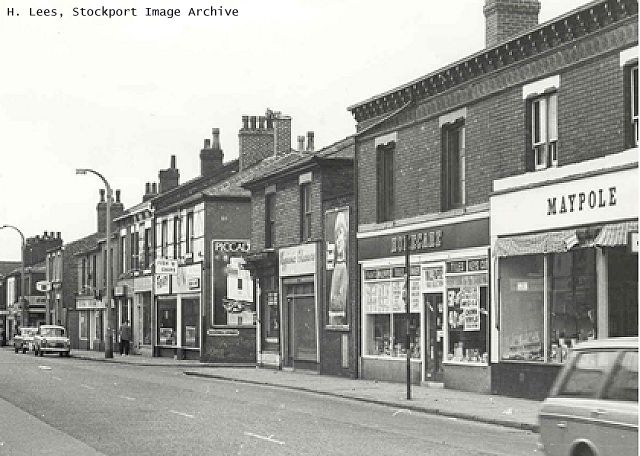
A 1960s view of Castle Street captures 96-98 trading under the 'Maypole' brand.
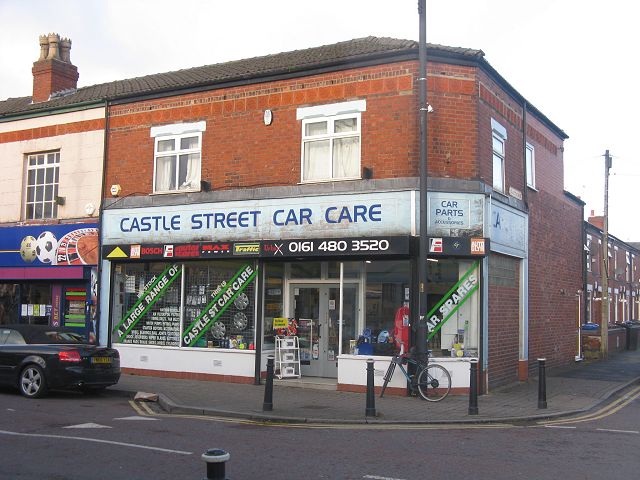
Car Care in 2017. The windows have been replaced by the modern version.
In 2024 no.96 is the home of SG Signs, a signmaker.
Retail pioneers
The history of grocery shops has been studied by a small number of authors; mentions of John Williams and Sons are hard to find. The following extracts are from James B. Jeffreys. Retail Trading in Britain 1850-1950. Cambridge: University Press, 1954 (Available online at Archive.org).
After the turn of the century some small but significant changes in retailing methods began to be made by existing multiple shop firms, or to be introduced by new firms. The growth of food manufacture, the improved standards in quality, grading and marking of imported produce and the greater experience and larger capital resources of many multiple shop firms were the main factors bringing about the changes.More recent developments, although without specific mention of John Williams & Son, are covered by Andrew Seth & Tony Randall. The Grocers: The Rise and Rise of Supermarket Chains. London : Kogan Page, 2001.
The rising volume of factory-made products enabled the grocery type of multiple shop firms to start competing with the traditional grocer on his own ground ... Shops began to be improved in layout, larger shops were acquired to sell the larger stocks and ranges of goods, and additional fittings, for example display cases, the bacon slicer and the cash register, began to be installed.
On the provisions side marble slabs and tiled floors began to replace the deal or mahogany counters and the sawdust, and some firms began to display goods behind windows instead of leaving them open to the dirt and dust from the streets ... Some of the newer provision type of multiple shop firms aimed at overcoming the prejudices of the middle classes regarding 'foreign' butter, bacon, cheese and eggs and, equally significant, began to make large-scale purchases of home-grown produce.
Before 1914 these new trends were in their infancy ... Nevertheless the smaller local and regional firms which had been increasing in importance alongside the giants, firms such as John Sainsbury and David Greig of London, Coopers of Liverpool, Burgons and John Williams of Manchester and Willsons of Newcastle were developing successfully some of the newer techniques of multiple shop retailing.
Note: the other John Williams
There was, in the Edwardian period, another shopkeeper called John Williams trading in Davenport at 187-189 Bramhall Lane. Born in Montgomeryshire, Wales and with two daughters but no sons, this Mr Williams and his life and times are chronicled along with the the other shops nearby in our feature no. 38 Walton's Terrace and its neighbours.
Sources
We've made extensive use online of Ancestry.co.uk, Findmypast.co.uk, Leicester University's Historical Directories and Cheshire County Council's directories collection in researching this feature as well as the directories archive on our own website.
Historical postcards are from our own collection, as well as Levenshulme History, Chorlton History, Mark Fynn's superb Manchester Postcards collection and Eric Larson of Cardcow.com.
Modern illustrations are our own or from Google Streetview.
Thanks
Our thanks are due to Sue Bailey, doyen of Woodsmoor historians, for her father Philip Bradley's 1980s photographs, and as always the Local History librarians of Stockport and Manchester.
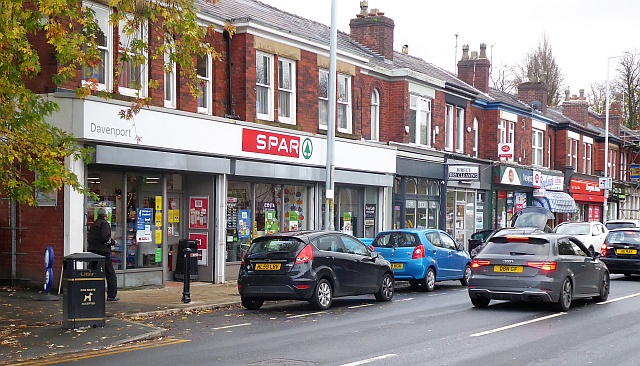
Autumn 2020.
Written by Charlie Hulme, January 2007. Updated July 2025.